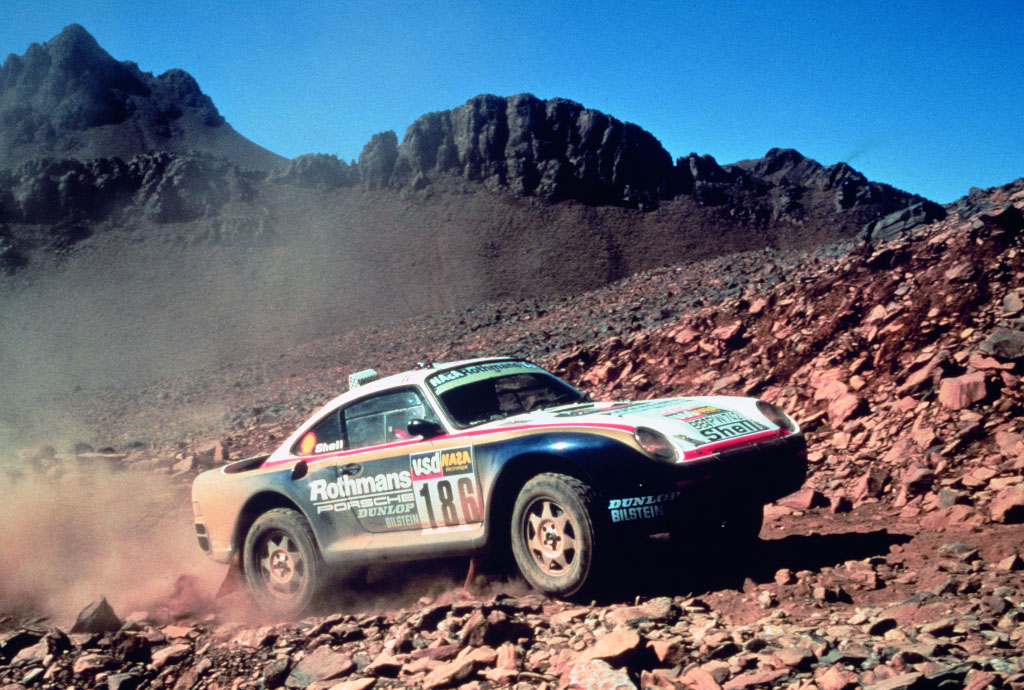
Porsche 911 - History of Motorsport
.jpg)
Automobile salons give the auto industry the opportunity to test the public's interest and taste for future developments.
At the IAA 1981, Porsche presented the study of a 911 Turbo Cabriolet with four-wheel drive, from which the production model Porsche 911 Cabriolet has emerged.
At the IAA 1983, the Porsche study applies to a Group B competition car, that is to say a sports device close to series production, but which is also fully roadworthy and suitable for everyday use.
The "Group B" is based in form and technical conception on the Porsche 911 Turbo. Its modified body, born in the wind tunnel, has a drag coefficient of 0.32, significantly reduced driving resistance and good downforce values.
The engine is an offshoot of the Porsche World Championship cars 936 and 956: water-cooled four-valve cylinder heads with hydraulic valve lash adjustment and double turbochargers are the features of this high-performance version of the classic air-cooled six-cylinder. The 2.85 liter displacement is such that, taking into account the turbo factor, a "sport stroke" of 4 liters results.
From this, the "Group B" produces 400 HP, which are used for optimum utilization via a six-speed gearbox.
The high performance in the light car (1115 kg) is optimally brought to the floor by a new technology of the all-wheel drive. This electronically controlled system, developed by Porsche to optimize driving dynamics, optimizes four-wheel drive in driving practice. Electronic control ensures different power transmission to the front and rear axles depending on the road conditions; a different design is better for wet roads than for gravel or snow. This driving dynamics optimization, which is designed for road conditions, is programmed and can be called up or changed by the driver as required. The whole thing works together with a chassis in the latest racing car technology with double wishbone suspension of all wheels and adjustable stabilizers. Also noticeable is the unusual wheel size of 17 inches with Dunlop tires based on the Denloc safety system.
The racing technology of the form, engine and chassis also correspond to the driving performance of the Group B Porsche: 300 km / h top speed and acceleration values from 0 to 100 km / h in 4.9 s and 0 - 200 km / h in 15.4 s can be realized.
This IAA study has a specific pilot function for Porsche. In the course of 1984 the final group B car was to be built and until the end of the year interested sports customers were offered a racing version and a rally version. The homologation is after the construction of 200 vehicles planned for the 1985 sports season. After the introduction of the professional racing car Porsche 956, Porsche saw a group B car for mass sports as an addition to its range of powerful competitive vehicles.
.jpg)
"The faster and more powerful a car, the higher the safety reserves have to be. That is why Porsche was the first manufacturer to develop Dunlop's 10-year development and the Denloc safety system, which has been tried and tested on over 100,000 vehicles, has been intensively tested in motorsport. The successful Rothmans Porsche 956C on Dunlop tires with Denloc system have been driving and winning since November 1982
The 911 "Group B", on 17 "Dunlop steel belt tires in an equilibrium contour for speeds well over 300 km / h on Porsche alloy wheels with Denloc safety contour for the Denloc bead.
This was developed from scratch, super wide and super flat 17 "tires is a world first for production vehicles. In the dimensions 235/40 VR 17 on the front axle and 255/40 VR 17 on the rear axle, the Dunlop SP Sport Denloc D4 combines the properties of a top tire in handling, wet behavior and safe cornering behavior with the necessary comfort, mileage and low noise as well as Safety and mobility of the Denloc wheel / tire safety and emergency running system.
The Denloc safety and emergency running system gives the driver the certainty that if there is a sudden loss of pressure, the tire stays on the rim and the vehicle has to be kept fully under control.

Porsche 911 - History of Motorsport
.jpg)
Driven by Dreams

Porsche Press kit

Porsche Literature

Our Porsche Cars